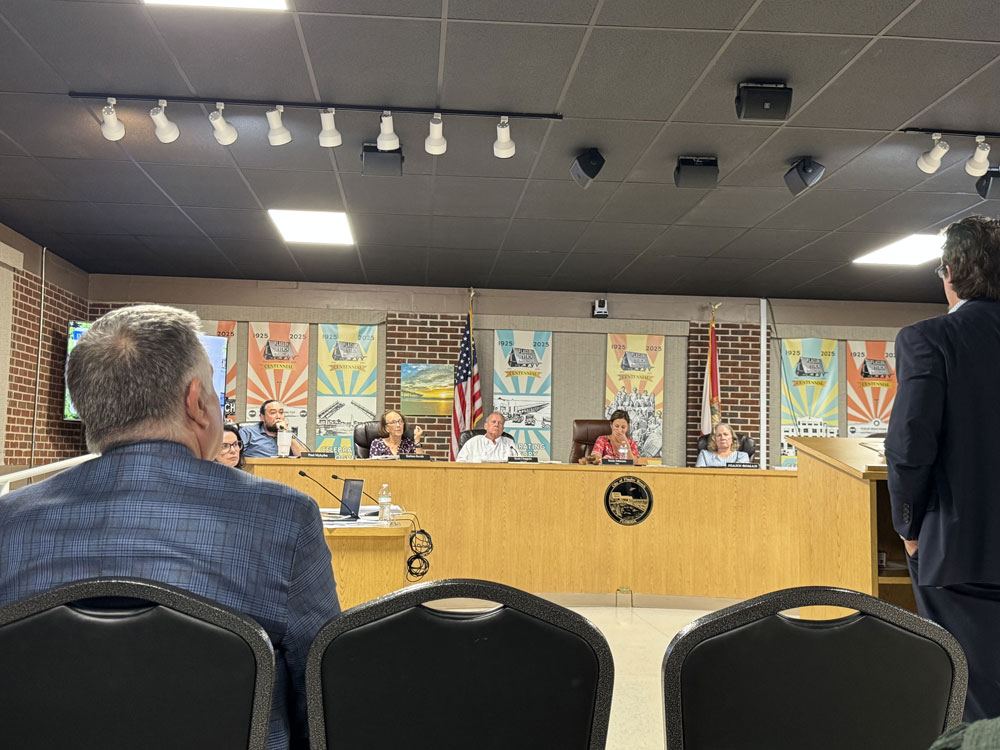
In a striking reversal from its unanimous recommendation approving Veranda Bay’s annexation into Flagler Beach last year, before the threat of a lawsuit suspended further regulatory steps, the Flagler Beach Planning Board Tuesday denied recommending approval on a series of 4-1 votes.
For Veranda Bay, now with its satellite known as Summertown, it is the latest blow in a six-year slog through sustained public opposition, litigation, official courtship, second thoughts and now uncertainty. The alternative to annexation of 2,230 planned housing units could be less regulated development along county standards or annexation into Palm Coast, a fear that had spurred Flagler Beach city commissioners last year to urge Veranda Bay to annex.
The planning board vote by a panel with four different members compared to last year’s makeup (there were two absent members) sends the proposed annexation of 756 acres on both sides of John Anderson Highway to the City Commission, which takes up the matter Thursday. The commission has only one new member since it first considered annexation.
The commission’s members were originally in strong support for it. That support had been wavering the more commissioners discussed it.
Almost two years ago Suzie Johnston, then mayor of Flagler Beach, wrote a letter on the city commission’s behalf to Veranda Bay’s representative, all but begging him to apply for annexation. Now chair of the Planning and Architecture Review Board (known as the PAR board), she passed the gavel three and a half hours into Tuesday’s hearing and made a motion to recommend annexation. There was dead silence from her four colleagues.
The motion would have failed had City Attorney Drew Smith not pressed the panel to either approve or deny. It denied. They took a technical but required vote to affirm that denial, then a series of three subsequent votes on related items, all in opposition.
Barbara Revels, Scott Chappuis, Paul Mykytka and Joann Soman were against recommending, with Johnston in favor.
For all their decisiveness, the votes were not necessarily as terminal as they appeared: Revels–a former county commissioner who had also served as a board member of Preserve Flagler Beach Bulow Creek, an advocacy group created to oppose Veranda Bay– was inclined to approve a portion of the annexation. Mykytka qualified his opposition to suggest that it was “based on the information provided,” as if he might have been open to a different outcome with better information (though it’s not clear what else Veranda Bay could provide).
Veranda Bay had turned in the nearly 400-page proposal only Friday and was making amendments until Monday. (See the document here.)
Revels, the most experienced parliamentarian on the panel, attempted to delay the discussion to Oct. 15 to give the board and the public more time to review the material. “This is the most important thing to happen to the citizens of Flagler Beach in a long time, and a long time forward,” Revels said. “I don’t think two days was enough to prepare with alternate documents even coming out on Monday.”
The record made available to the public was also incomplete: none of the presentation Lupita McClenning, the city planner, used and flashed on screens for the commission as the basis for her analysis was accessible.
Revels’s motion for an extension failed, 3-2, with Johnston tipping the majority. Her vote in retrospect was a strategic misstep, giving the board more room to argue that, instead of analyzing the proposal purely on its merits, it was pressured into a decision on what would undeniably “dramatically, significantly and forever change the character and nature of Flagler Beach,” as John Tanner, the lawyer, former prosecutor and representative of the Bulow Creek group, told the panel. (Tanner is a resident of John Anderson Highway.)
Veranda Bay last year proposed to voluntarily annex 899 into Flagler Beach. It would have wrapped around a small enclave of county residents. Seizing on a rarely enforced but still current provision of state law that prohibits such enclaves, opponents of the development signaled they’d sue if annexation went ahead. The Flagler Beach City Commission, which had invited Veranda Bay to annex, tabled the proposal indefinitely.
Tuesday’s resubmission by Ken Belshe, who represents Veranda Bay (officially Palm Coast Intracoastal and Miranda Bay investments in records), and his attorneys, Michael Chiumento and Jay Livingston, was the first reemergence of the annexation proposal since last December. Belshe has been the face of the development since it reemerged in 2019, after a long hiatus. It had been a Bobby Ginn property and proposal a decade and a half earlier.
It changed. It is now a 756-acre proposal. It’s been split into two segments: Veranda Bay and Summetwown. The two are technically and financially separate developments. “This is all confusing. It’s confusing to me and I helped put it all together,” Belshe said.
Veranda Bay, the more familiar part of the development (where many homes have been built), would include 211 acres on the east side of John Anderson Highway, south of State Road 100. Some 122 lots on 161 acres have been developed already, with roads, water, sewer, and model home sites.
Veranda Bay would be limited to 377 residential units–single-family homes, duplexes, apartments–16,200 square feet of commercial space and 150 marina berths. Open space would amount to 40 percent of the land. At buildout, that portion would have an estimated population of 784. (Flagler Beach has a population of about 5,000.)
Summertown consists of 514 acres west of John Anderson Highway and south of 100. It would equate to a city about the size of Bunnell–1,640 residential units, 640,000 to 840,000 square feet of commercial and other non-residential space (depending on where you look in the record), with a 250-room hotel. The residential units would include 1,100 apartments and 500 single-family homes. No short-term rentals would be allowed. Resort condominium rentals would be allowed, with a six-month minimum.
The split wasn’t an affectation. “We have distinct ownership structure of these,” Belshe said. “The same owners are not on the west side as on the east side. There’s different financing on the east side versus the west side. It makes sense that these are two separate applications and two separate developments.”
He added: “I represent both, but they are different.”
The changes did not alter the essence of the opposition. Caleb Hathaway, a resident, called the 100-foot buffer with Bulow Creek “pathetically small,” saying he could throw a football that distance. “You’re talking about 1600 homes. That’s a tremendous amount of impact. I don’t care if it’s 400 feet away, it’s still going to impact it some way,” Hathaway said.
Flooding, traffic, impact on water and sewer infrastructure and the number of residential units all drew concerns, including from Revels, who noted the already-poor service level of John Andeson Highway. “Nothing is going to change other than it’s going to get worse,” she said, with thousands of additional cars ahead.
Mykytka, one of the board members, had concerns about tree protection, signage, the 100-foot buffer with Bulow Creek (that size buffer was the result of pressure from County Commission Chair Andy Dance), residential-home design guidelines, and the development’s fiscal impact. “The only things I’ve seen in the application and previous presentations are developer-provided projections for taxes and impact fees, and I haven’t seen costs to the city for what all this means,” Mykytka said. “Revenue projections are great, but they’re coming from the developer. Has the city corroborated those?”
“We’re still in the plus, even after services and the cost in there,” McClenning, the city planner, said.
Mykytka was displeased with private amenities within the two developments. “I do have concerns that stuff like that would not benefit the city as a whole,” he said. “There’s a sidewalk in Flagler Beach that is owned by an HOA, and they don’t like you walking on their sidewalk. I just don’t want more situations like that to that extent.”
There were other issues. Sarah Spector, the assistant county attorney (who’d drafted a summary of the county’s concerns in a memo), told the panel that 118 individual owners “have not consented” to the annexation proposal. At least their consent was not in the record. The development is required to build a “spine road” in Sumemr Town, but there is still too much vagueness from the county’s perspective as to when that road must be built. The traffic analysis is also lacking, in the county’s view, as is the precision of buffer lines along John Anderson Highway and Bulow Creek.
“We’re not like Ponte Vedra, we’re not like Daytona, we’re not like St Johns, we’re not like part of Jacksonville, definitely not like the West Coast,” Matt hathaway, a long-time opponent of the development, said. “I’m not saying those are bad, but they’re different. And why do we want to become that? Not necessarily completely, but we’re trending in that direction. So it’s our responsibility as board members, citizens, commissioners, to keep that feel because that’s why we’re here.”
Chiumento and Belshe repeatedly defended the buffer with Bulow Creek, stressing that the development has no land bordering the creek. “The county is in control of what gets built on or adjacent to the creek, because they own that land,” Chiumento said. Flooding, he said, “is not permitted,” with all waters on the development required to stay on the development. Belshe said the city has been dumping 700,000 gallons a day of treated effluent into the Intracoastal. The development is building in infrastructure that would take all that recycled effluent and use it on its lawns, helping the city meet a deadline in the 2030s, when, by law, that effluent may no longer go into the Intracoastal.
“We hear about public participation. Mr. Hathaway talked about it. Obviously would like to see this thing delayed again,” Chiumento said. “But I remind you all that this project started in January of 24 at the request of the city. We’ve had, excluding tonight, we’ve had over 20 hours of public hearings on this project. Nothing has really significantly changed.”
All the infrastructure, Belshe said, is the development’s responsibility. Every house so far built has averaged $22,000 in development impact fees paid to local governments (schools and the county), per house.
“as I’ve said to the commission before, I’m ready, willing and able and excited about being a part of Flagler Beach,” Belshe said. “We’ve made a significant investment here. We put millions and millions of dollars into infrastructure. We’ve spent millions of dollars on this property. We are ready to be a champion of Flagler Beach and to be its best corporate citizen, but I can’t keep doing this, being fought back.”
He was fought back.
![]()






























Take says
I love when a developer tries to ‘guilt’ the board about how much money they’ve already spent & how much time they have invested to get their project pushed through. It’s a smoke & mirrors game to distract & confuse everyone from the small, but huge changes to the plans & agreements of the hundreds of documents each time they are turned down. They were able to ‘get around’ the enclave of the unincorporated properties in the middle of their mess, so they divided their land into smaller parcels, changed to the names of the owners but still own it. They are only asking for just a few of the parcels to be annexed now, but over time all the rest will quietly be annexed too & then it will be exactly what they want.
Ms. Johnson initiated all of this annexation as her FB mayor seat was ending & is now on the planning board to push it through….Quick, before no one notices.
The developer couldn’t get what they wanted from the county, so ‘someone’ suggested the ‘fools in Flagler Beach’ will surely fall for this project & agree to everything with no questions asked …….
Thank you Barbara & Scott for seeing beyond fake data & promises of huge money to the city.
And also seeing the BIG FUTURE PICTURE OF THE DESTRUCTION OF THIS AREA !!
Let’s hope the commissioners are as intelligent…..?
JimboXYZ says
Another Vision/Imagine of 2050 fail. The money ran out, most of it never was there in the 1st place. 4 years of wasted energy, that’s the legacy the Biden-Harris growth will be, like the bailout economy of Bush-Cheney, Obama-Biden. History repeats itself. The largest employer near the SR-100 & John Anderson area, Boston Whaler is closing operations. What a mess.
Jackson says
Common people. The PARB didn’t seem that educated last night. Complaining about not receiving the paperwork until last Friday. Boo hoo. It’s your job. Thanks Suzie for supporting annexation. The city of Flagler Beach needs all the tax revenue they can get. The homes WILL be built so why not take the revenue wherever it comes. We will be responsible for water and safety so will need that money. Hope the Commission supports revenue by annexing.
Sherry says
OOPS! I just stubbed my toe and then broke a nail! Maga, can you please help me out with Fox BS words to somehow “blame it ALL” on Presidents Obama and Biden? Thanks! LOL! LOL! LOL!
The Villa Beach Walker says
It seems that former City of Flagler Beach Mayor Johnson is the only one on the PAR board who understands the current reality in Flagler Beach and Flagler County. The county’s major employer has shut down. The next major employers are the hospitals and the school district, on which no one can build a tax base. Infrastructure needs to be maintained, and that is paid for by collecting taxes. Beachside and intracoastal tourism dollars offer an alternative to RAISING ALL COUNTY AND CITY RESIDENTS’ TAXES. What’s happening with Veranda Bay is clear NIMBY. The ‘headwaters of Bulow Creek’ aren’t being threatened as the county owns all the property surrounding the headwaters. What’s being threatened is the homeowners along John Anderson, and they are going all out to make sure that this property, which they DON’T OWN, is not developed. Summertown could be the best thing to happen to Flagler Beach EVER. It creates homes for new residents and accommodations for tourists who will spend money here. But it will add vehicles traveling over John Anderson. As a homeowner and taxpayer living on A1A, I say welcome Summertown, and to those living on John Anderson regarding traffic: ‘get used to it’.
Pete Petroski says
Just keep it up Flagler Beach. Palm Coast is patiently waiting. If you do not annex, I guarantee you the City of Palm Coast will happily take it into their city boundaries. If you want the tax money, you better take it while you can. You can protect your city, while still making sure the developer follows the rules.
Using Common Sense says
“Chiumento said. Flooding, he said, “is not permitted.” Really? Tell that to God. What a joke. Chiumento and Livingston are the common denominators in every urban sprawl, growth at any cost, up zoning , and incompatible development attempt I have seen. These despicable money grabs perpetuated against local residents are destroying the environment, threatening the fragile ecosystems, causing traffic congestion, lowering our quality of life, causing flooding problems, increasing the cost of our utility fees, polluting the air and water, and increasing demands beyond the capacity of our infrastructure. This area can never be replaced once destroyed. It is a unique natural resource, home to countless wildlife species and migratory birds. STOP THE DESTRUCTION OF THE VERY REASON WE CHOSE TO LIVE IN FLAGLER COUNTY!!! ( Flaglerlive, please hire an editor)
MT says
Re: The Village Beach Walker comment
This develop is not “NIMBY”. It is the surrounding property owners concerned about the destruction of the valuable natural land that can never be replaced once gone. They are concerned about the future physical ill effects from the development to their own properties, the decline in value of it & and the change of the designated scenic byway adjoined by the end of John Anderson in Volusia County known as the Loop. There IS danger to the ‘headwaters of bulow creek’ as the county DOES NOT OWN all the property surrounding it. The largest part of the developer’s property butts up next to Bulow Creek, which means no BUFFER.
And the 100ft buffer offered between the two, means absolutely nothing with natural land next to commercial hardscape.
As far as the traffic & other major changes, think again if you don’t think it will effect beachside city residents.
The City will not make the money ‘promised’. They will actually have to spend extra money now & in the future to support all the changes: new fire station & staff, new police station & staff, trash pick up, road repairs, more code enforcement, build a bigger city hall to hold all the new staff & for meetings for the growing population, etc….don’t forget all the 1000’s of added residents from developments on Roberts Rd, Colbert Lane, & Rt 100 that are in the works now to the mix…. even though they are not technically in FB city limits.